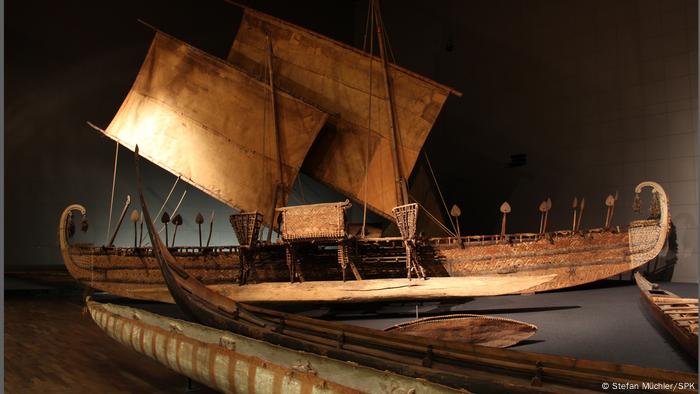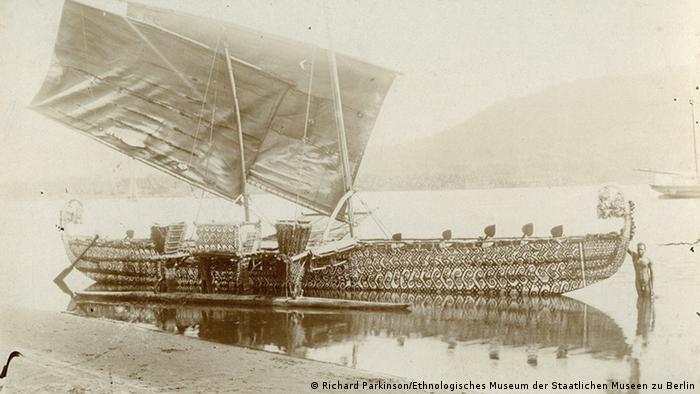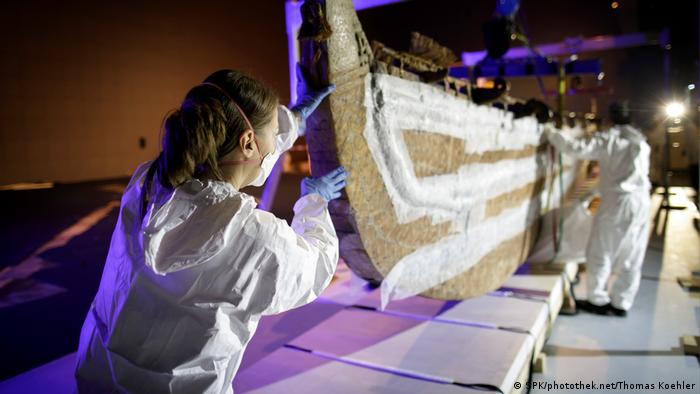In a new book, German historian Götz Aly reveals how a boat was taken from the South Pacific and ended up in a German museum. Will it spark a new restitution debate?

Is the Luf boat yet another stolen colonial artifact?
The announcement last month that Germany would return the Benin Bronzes — 13th century sculptures stolen from Africa and since displayed in national museums — to Nigeria caused widespread celebration.
It was a long-overdue win in the fight for the restitution of artworks and artifacts sitting in museum collections that were often acquired illicitly by European colonial powers.
But the recent publication of Das Prachtboot: Wie Deutsche die Kunstschätze der Südsee raubten ("The Magnificent Boat: How Germans Stole the Art Treasures of the South Seas"), by historian Götz Aly, has added another long-hidden dimension to the restitution debate.
While much of the discussion has been around colonial plundering in Africa, Aly's book focuses on the South Pacific region also colonized by European powers in the 19th century. In particular, the book discusses a unique 16-meter (52-foot) long and 10-meter high sailboat and its journey from Papua New Guinea to the German capital.
Due to be unveiled in Berlin's long-delayed Humboldt Forum museum in autumn 2021, the massive exhibit is set to become the latest restitution battleground.

The Luf boat is a masterwork of New Guinean craftsmanship. But should it be returned?
Looted from the South Pacific?
In his look into Germany's stolen South Sea art treasures, Götz Aly reveals the grim circumstances that foreshadowed the arrival of the so-called Luf boat in Berlin.
In the late 19th century, Germany's colonial rulers ran a brutal regime on the Hermit Islands in Papua New Guinea's Bismarck Archipelago — the largest of which is Luf Island. German colonialists who shot the native people, robbed them, raped women or abducted young men for forced labor "generally had no fear of punishment," writes Aly. It might then be assumed that the Luf boat was a looted artifact and was not legally acquired.
Hermann Parzinger, the director of the Prussian Cultural Heritage Foundation (SPK) that owns and manages the Humboldt Forum collection, has so far denied that the boat was stolen.
In a recent statement obtained by the Süddeutsche Zeitung newspaper, the SPK said it will continue to display the boat but will re-brand it, so to speak, as a "memorial of the horrors of the German colonial era."
The SPK has a total of around 65,000 objects from the South Pacific in its possession. For many years, few in charge of museums and collections asked whether these had been legally acquired, despite the mounting number of restitution demands for colonial artifacts stolen from Africa.
In his look into Germany's stolen South Sea art treasures, Götz Aly reveals the grim circumstances that foreshadowed the arrival of the so-called Luf boat in Berlin.
In the late 19th century, Germany's colonial rulers ran a brutal regime on the Hermit Islands in Papua New Guinea's Bismarck Archipelago — the largest of which is Luf Island. German colonialists who shot the native people, robbed them, raped women or abducted young men for forced labor "generally had no fear of punishment," writes Aly. It might then be assumed that the Luf boat was a looted artifact and was not legally acquired.
Hermann Parzinger, the director of the Prussian Cultural Heritage Foundation (SPK) that owns and manages the Humboldt Forum collection, has so far denied that the boat was stolen.
In a recent statement obtained by the Süddeutsche Zeitung newspaper, the SPK said it will continue to display the boat but will re-brand it, so to speak, as a "memorial of the horrors of the German colonial era."
The SPK has a total of around 65,000 objects from the South Pacific in its possession. For many years, few in charge of museums and collections asked whether these had been legally acquired, despite the mounting number of restitution demands for colonial artifacts stolen from Africa.

Moving the 16-meter long boat to the Humboldt Forum might not be the only challenge amid possible restitution claims
New Guinean cultural heritage
Before Germany created a protectorate in New Guinea and its neighboring Pacific islands in the 1880s — an area stretching over 3,000 kilometers (1,860 miles) — the Indigenous people had a highly developed culture, especially in terms of arts, crafts and construction. Without using nails, they built large, seaworthy and richly ornamented boats that covered enormous distances and could seat up to 50 people.
Before the arrival of the Europeans, there were hundreds of such boats that sailed the South Pacific seas. According to Aly, all but the one now in Berlin's possession were destroyed during punitive expeditions that were common under colonial rule.
In 1882-83, many of the 400 inhabitants of Luf Island fell victim to such an expedition to the Bismarck Archipelago instigated by Hamburg entrepreneur Eduard Hernsheim.
More than 300 German marines raided the island, destroyed the huts and smashed the boats. Only a few dozen people survived.
Before Germany created a protectorate in New Guinea and its neighboring Pacific islands in the 1880s — an area stretching over 3,000 kilometers (1,860 miles) — the Indigenous people had a highly developed culture, especially in terms of arts, crafts and construction. Without using nails, they built large, seaworthy and richly ornamented boats that covered enormous distances and could seat up to 50 people.
Before the arrival of the Europeans, there were hundreds of such boats that sailed the South Pacific seas. According to Aly, all but the one now in Berlin's possession were destroyed during punitive expeditions that were common under colonial rule.
In 1882-83, many of the 400 inhabitants of Luf Island fell victim to such an expedition to the Bismarck Archipelago instigated by Hamburg entrepreneur Eduard Hernsheim.
More than 300 German marines raided the island, destroyed the huts and smashed the boats. Only a few dozen people survived.
Journey to Germany
Two decades after the raid, Max Thiel, director of German trading company Hernsheim & Co., visited the tiny island. In addition to the income made from plantations, trading the "curiosities of primitive peoples," as Aly describes the artifacts, was a profitable side business.
Thiel had gained possession of a boat in German New Guinea and got in touch with Felix von Luschan, who was head of the Oceanic division at Berlin's Ethnological Museum — the predecessor of the Humboldt Forum.
Little is known about how the vessel was acquired by Hernsheim & Co. as there was neither a sales receipt from the islanders nor evidence that it was stolen. What is known is that the boat changed hands for 6,000 German marks, a very high sum at the time, and was transported to Berlin.
Paternalism and 'indirect genocide'
For many years, those involved claimed that they simply wanted to preserve the islanders' culture, saying that since the population had declined so rapidly the boat was no longer needed.
The paternalistic legend persisted that the Germans had, in fact, saved the boat. Yet any need to save the vessel was precipitated by German colonists who had decimated the islander culture and population with their "indirect genocide," as Aly terms it.
The boat was long on display at the Ethnological Museum in Dahlem in Berlin before it was packed into a specially made crate in 2018 and transferred to the new Berlin City Palace.
But will its pending autumn display in the controversial Humboldt Forum collection be met with new questions about its origins?
A book-length report on the "Restitution of African Cultural Heritage" published in 2018 by French academics Benedicte Savoy and Felwine Sarr was instrumental in getting the ball rolling for the restitution of looted African art in Germany. With Götz Aly's latest publication, it is possible that another historian will launch a debate about the origins of South Pacific artifacts, and even their potential repatriation.
This article has been translated from German by Sarah Hucal
No comments:
Post a Comment